SPRING HAS ARRIVED and many butterflies (up to 35 species) are on the wing! It is at this time of year than many specialist species occur, such as the Grizzled Skipper. I had the privilege of seeing this chunky, plucky and totally engaging character last year, in its Welsh stronghold of Merthyr Mawr. For an account of this unforgettable experience please click here. However, the focus of this posting will be on the equally delightful Common Blue – Polyommatus Icarus. Mind you, I prefer to use the name Icarus Blue instead of Common Blue as there is nothing common about this beautiful butterfly. As the ecological geneticist E.B. Ford (1901-88) amusingly put it:
“Occasionally people describe a ‘beautiful, bright blue’ butterfly to me, and ask its name. Almost without fail their excitement dies when I tell them it is a Common Blue. I now tend to use the name which I first heard a few years ago, the Icarus Blue (after its scientific name, P. icarus). Now that keeps the smile on their faces.”
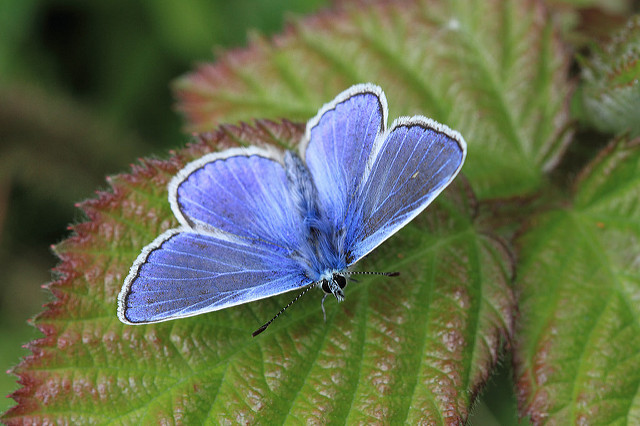
The beautiful, bright blue Common Blue can be more lyrically referred to as Icarus Blue
While the Common Blue is present throughout much of the Spring and Summer months the pictures that follow were all taken during May. In fact, they have two broods between May – June and August – September.
The Common Blue is found in a variety of grassy habitats including road verges woodland clearings disused railway lines quarries and coastal areas. Although very small (wingspan 29-36mm), their brilliant blue coloration makes them easy to spot and they can usually be seen basking in the evening sun at the base of a grassland valley (preferably south facing). They are also fond of the warmth that sand dunes provide (as in Kenfig Nature Reserve, South Wales). Such vallies provide shelter and warmth from strong gusts of wind, typical of Kenfig Nature Reserve’s exposed coastal dune landscape.
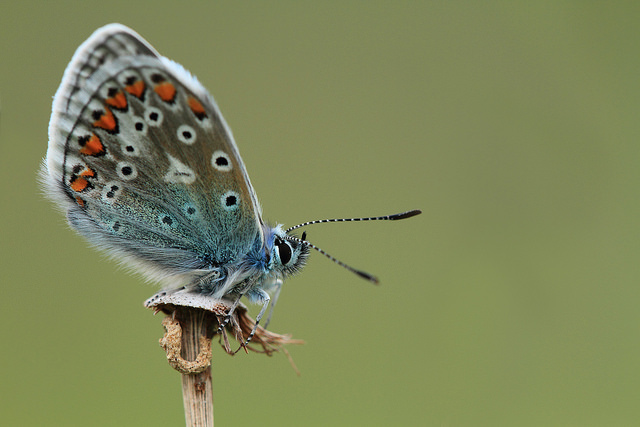
They can usually be seen basking in the evening sun at the base of a grassland valley
As with most butterflies, the brighter coloured males are most easily seen flying around while looking for females for which to mate. In contrast the females are more secretive in behaviour and are equally distinctive and beautiful in their own right. They differ greatly in the amount of blue and brown colour on their upper wings, both within colonies and between regions. Some are uniformly brown, although most have a dusting of blue scales towards the base.
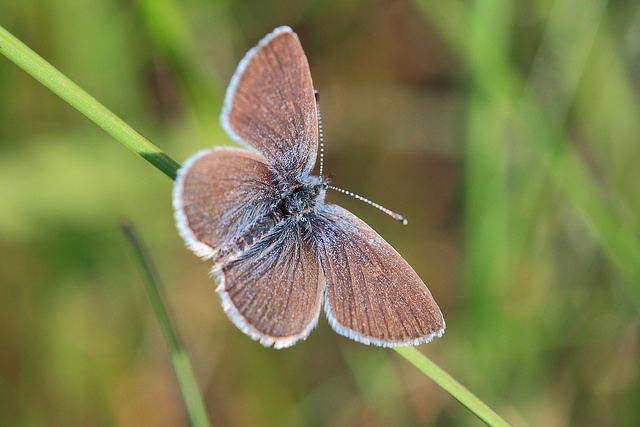
Females differ greatly in the amount of blue and brown colour on their upper wings.
Note the dusting of blue scales towards the base.
According to Jeremy Thomas (The Butterflies of Britain and Ireland p132), ‘the preponderance of blue markings increases the further one travels west and north, culminating in a magnificent form called mariscolore, which is regarded as a distinct subspecies by some entomologists.’ It is certainly one of the most beautiful of all British butterflies. Not only are the wings a clear deep blue, but the orange spots are also enlarged almost into a band.
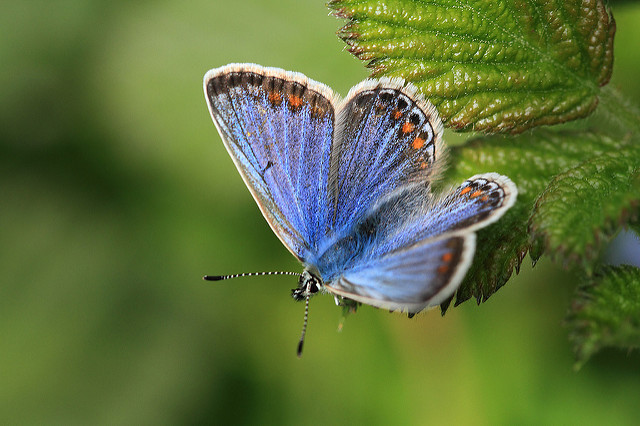
(above and below) One of the most beautiful of all British butterflies, culminating in the magnificent form called Mariscolore, with clear deep blue wings and bright orange spots.
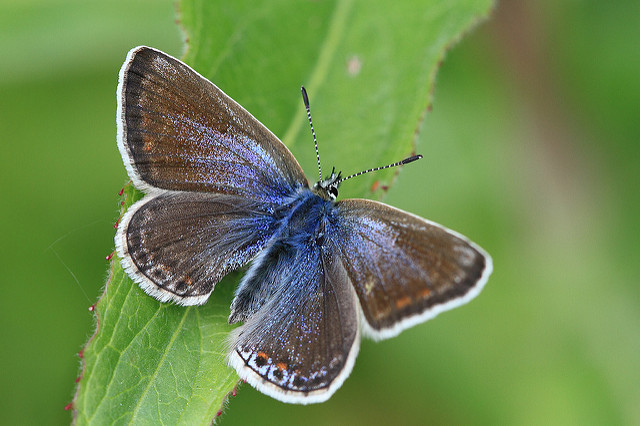
The eye catching wings of the Common Blue derive from minute scales arranged in overlapping tiles across both surfaces of each wing. As Jeremy Thomas explains:
‘The colours are produced in a combination of ways. Shining physical tints arise from the elaborate internal structure of each scale, consisting of multiple layers of three-dimensional diffraction gratings in the chitin from which they are made. These scatter light to create Tyndall blues, the same effect that produces blues in the human eyes and also in the sky. Pigments in each scale make an even greater contribution to wing colour. Many of these are synthesised by the chrysalis during scale development, which occurs a few days before adult emergence during a crucial period when different genes are switched on and off to regulate the intricate patterns and colours of the upper-and underwings. (The Butterflies of Britain and Ireland p131).
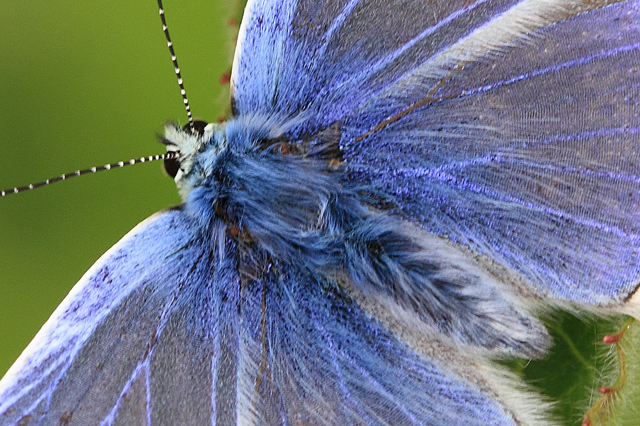
The scales scatter light to create Tyndall blues, the same effect that produces blues
in the human eyes and also in the sky.
Finding mating butterflies in the field is fairly easy, particularly with common species such as the Common Blue. They can sometimes be seen flying around, the larger female carrying the male dangling behind her, but usually when mating they sit still on a leaf or stout grass stem. The spermatophore, a package of sperm and nutrients the female needs to produce and lay eggs can clearly be seen with a macro lense.
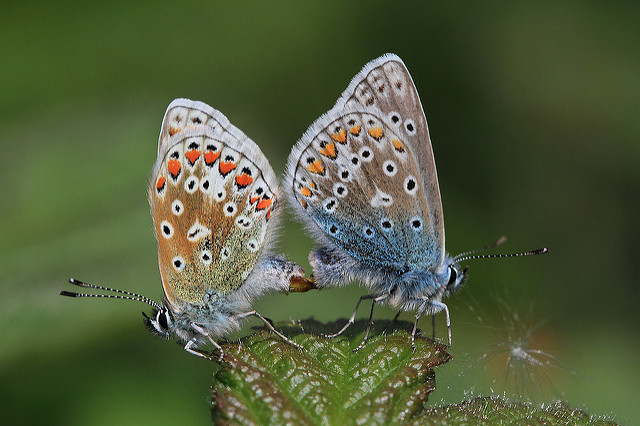
The spermatophore, a package of sperm and nutrients the female needs to produce
and lay eggs can clearly be seen.
According to recent research, the sperm of the male butterflies has a strange property in that about 90% of it is non fertile – essentially filler for the female’s sperm storage organs that tricks females into thinking they have all the sperm they need to fertilise the eggs.
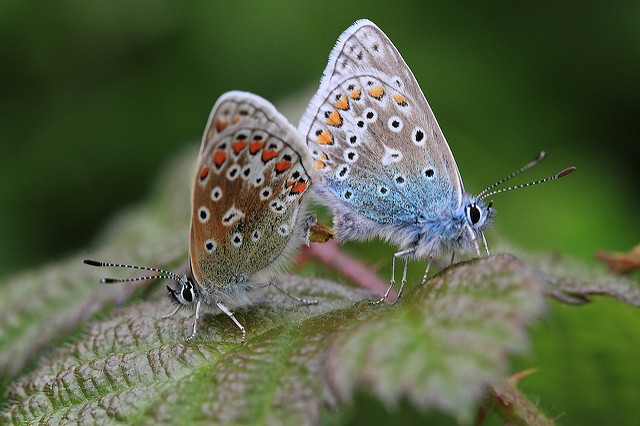
Finding mating butterflies in the field is fairly easy, particularly
with common species such as the Common Blue.
Mating for Common Blues is quite a lengthy process (they were still at it after an hour!) and while they initiate the mating in typical back-to-back fashion this does not prevent them from moving about from side to side or opening their wings as the male is clearly doing.
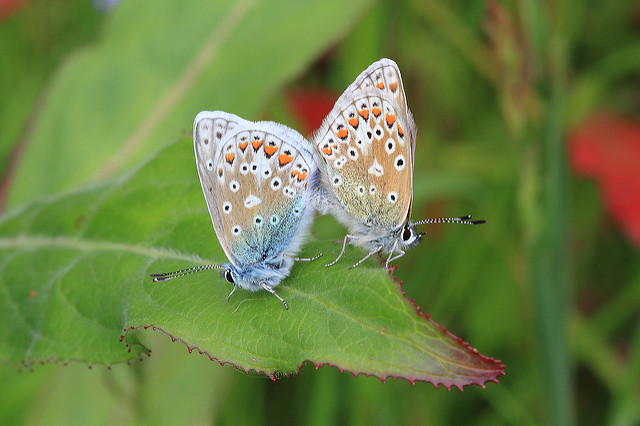
Mating for Common Blues is quite a lengthy process (they were still at it after an hour!)
Many male butterflies deliver more than just sperm to their mates. Most provide a spermatophore, a package of sperm and nutrients the female needs to produce and lay eggs.
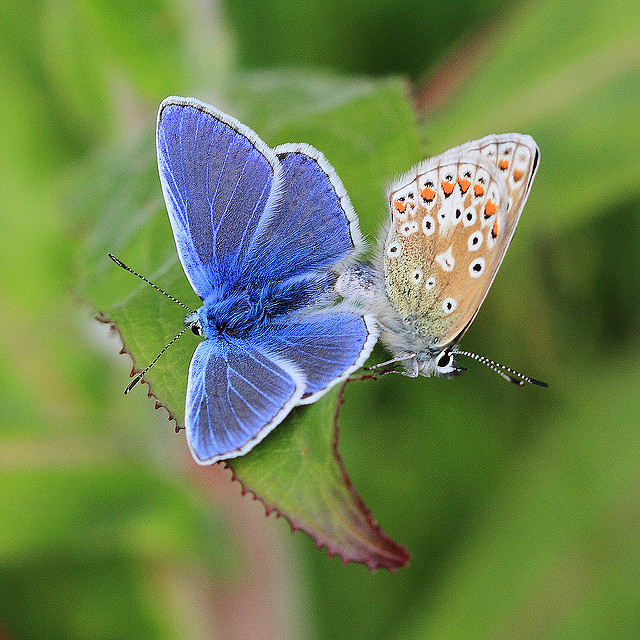
Mating is initiated in typical back-to-back fashion, this does not prevent them from
moving about from side to side or opening their wings as the male is clearly doing.
At the slightest disturbance they tend to separate. In any case it is impossible to see what is really going on with the naked eye, as the genitalia are too small. One could somehow try to persuade the mating couple to sit on the stage of a microscope, but that is hardly practical. However armed with my MPE macro it was feasible to capture pictures showing the genitalia in some detail.
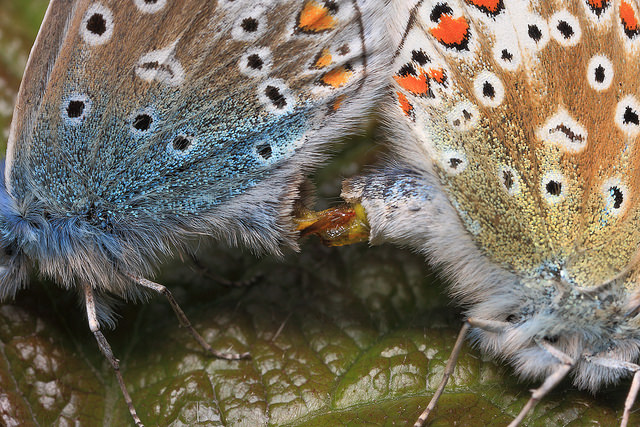
Canon MPE 65mm macro at 3x magnification
During mating, males use clasping organs on their abdomens to grasp females. In his excellent book, “A Buzz in the Meadow”, Dave Goulson gives a detailed description:
“The genitalia of male butterflies consist of a pair of rather barbaric claspers, which lock on to the female during mating and between which the tube-like phallus protrudes. Place your wrists together with the palms of your hands facing one another and you get a rough idea of the design of the claspers. They are hinged at the base, so that they can open out and then close on the female like gripping irons. In some butterflies the claspers are armed with sharp, incurved, talon-like hooks to help them grip.” Dave Goulson, “A Buzz in the Meadow” page 86
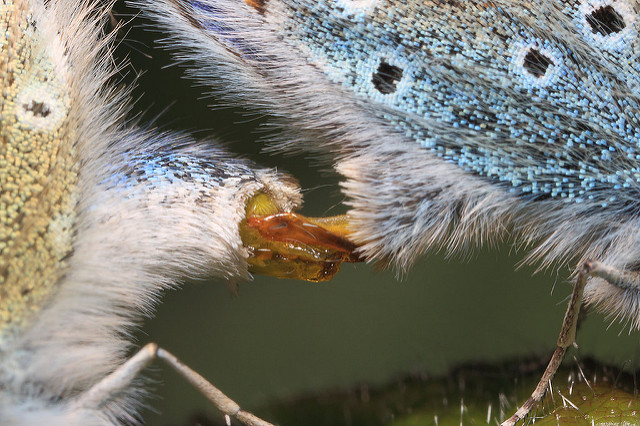
Canon MPE 65mm macro at 4x magnification
Once mated the female will look for a suitable plant on which to deposit her eggs, such as Common Bird’s-foot-trefoil – Lotus corniculatus (the caterpillar’s main food plant), Greater Bird’s-foot-trefoil – L. pedunculatus, Black Medick – Medicago lupulin, Common Restharrow – Adonis reopens, White Clover – Trillium reopens or Lesser Trefoil – T. dubium.
As the day closes the males and females will often be seen basking in weak sunshine with wings held flat and most often facing downwards and in this roosting position they are most approachable.
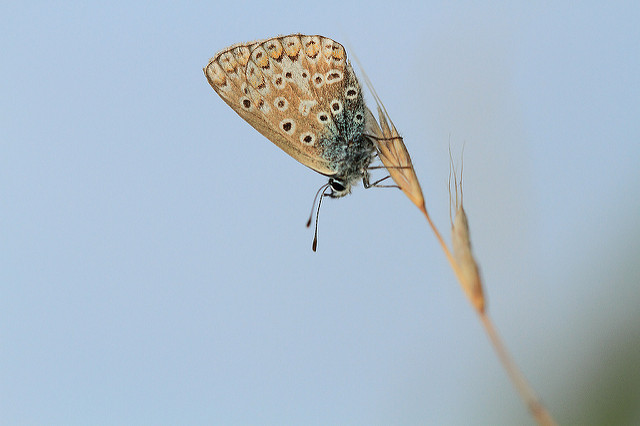

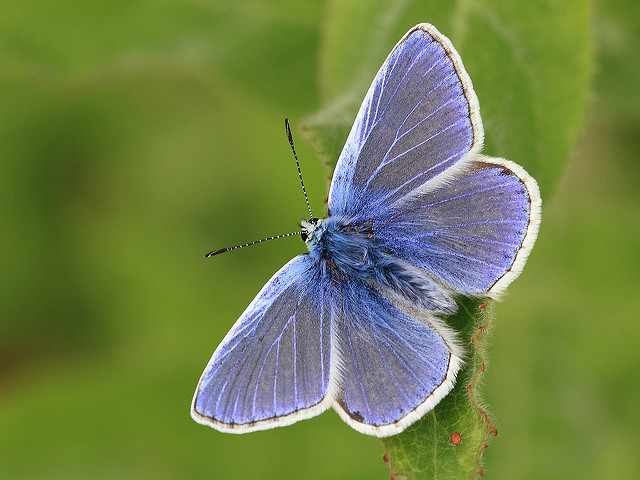
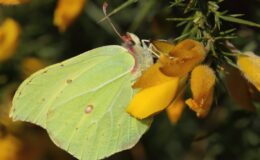
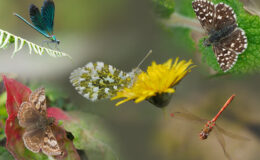
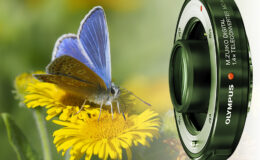
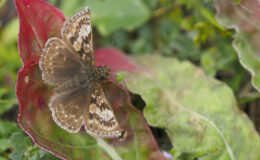
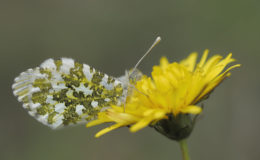
Leave a Comment